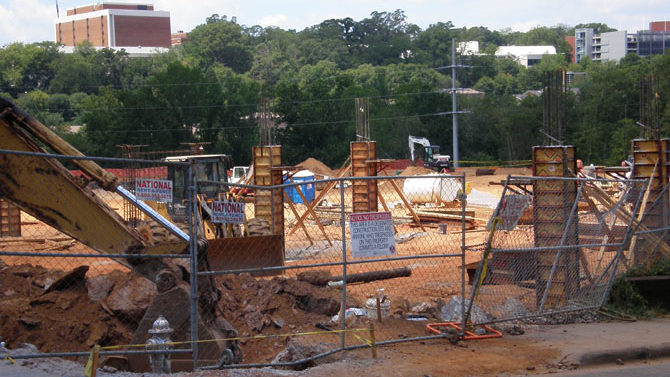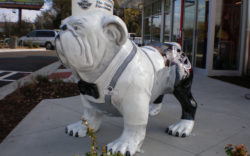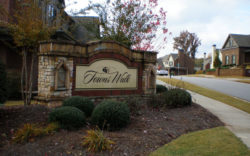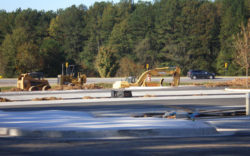Living in the Carr’s Hill neighborhood just off Little Oconee Street, I couldn’t help but notice the latest development of—you guessed it—more student housing. A five-story building will include some commercial space and 316 bedrooms, as if there’s a shortage of student housing.
My main concern is how the construction will impact environmental quality, with this site being so close to the Oconee River. As yet another plot is clear cut and dozed, I can’t help but worry that, if this haphazard building continues, there will soon be no natural unmediated environment within the city. Until now, the land was like a buffer separating Carr’s Hill from the shadow of the University of Georgia. Walking through, one  would become immersed in nature: the splashing water, the indigenous vegetation, the (previously) happy animals.
Developer Roger Kennedy plans to extend the North Oconee River Greenway along the site, which is good for taking longer walks on the trail and making the area accessible to others. If more students get outside, perhaps it will increase their likelihood of supporting environmental protection measures in Athens.
Typically, construction projects are bad news for nearby water resources, the main problem being sedimentation. If enough freshly turned soil finds its way into the creek, thanks to our frequent summer showers, sedimentation can alter water temperatures and plant growth, not to mention animal habitats. Murkier water reduces the amount of sunlight available to aquatic plants for photosynthesis. Silt clogs fishes’ gills and fills in spawning areas.
Not to worry, though, modern technology provides us with a wholly effective means to combat this problem: a woven synthetic fabric held in the ground by some wooden stakes, otherwise known as a silt fence. These fences are not very effective, but what’s worse is when this simple device is poorly installed, which is what I saw on my walk between the construction site and creek. The fence was present, but in many places the bottom of the fence didn’t even touch the ground, allowing dirt to run down to the water. After installation, these fences need to be maintained and routinely monitored, especially after the many heavy rains we’ve had lately.
Some communities require a double fence, and our city could be more vigilant about monitoring the installation and maintenance of these types of fences. The heavy rains we’ve had call for it. Better yet, another trick to minimize construction erosion is by leaving some natural vegetation in place, as opposed to clearcutting the once-picturesque wooded area. Not only would this decrease erosion, but keeping some trees around would also enhance the aesthetic quality of the newly erected apartment complex. For a community trying to promote its reputation as green and sustainable, this would have been a better option. Who doesn’t enjoy some natural scenery from the back porch?
Unfortunately, an important part of our Georgia heritage has been lost. Four months ago, this now-bulldozed site was home to a rare granite outcropping, an exposed section of rock which provides a unique habitat for specific plants and animals. While these outcroppings are characteristic of the Piedmont and Appalachian regions and especially prominent in Georgia, sadly, they do not receive special conservation status.
It’s hard to top Mother Nature in terms of looks, but a developer can at least try. And a stack of large, gray cinderblocks ain’t cutting it. I’m sure it will only enhance one’s experience on the new Greenway extension by serving as an unattractive comparison to make one appreciate the aesthetic appeal of nature. Hopefully, some vegetative cover will soon remedy this blot on the landscape.
Some worry how this development will affect traffic in the area. Athens-Clarke County plans to install a traffic light on Oconee Street. On the plus side, maybe the building will reduce congestion overall in the city and the air pollution that comes with it. More than 300 students who would otherwise be driving will live a 15 minute stroll from class or downtown.
This plot marks the foundation of Athens where one of its earliest buildings was constructed: the Easley Mill, a flour and grist mill. It’s the site where Daniel Easley and John Milledge met to for the land deal that started UGA, the nation’s first land-grant university, in 1801 and founded the City of Athens. Perhaps a marker could be installed to commemorate “The Flats at Easley Mill.” While the demand for newer buildings with more amenities closer to campus is ever increasing, we should require a responsible approach to protecting water quality. The natural environment of Athens is something we all treasure and should strive to protect.
Like what you just read? Support Flagpole by making a donation today. Every dollar you give helps fund our ongoing mission to provide Athens with quality, independent journalism.










